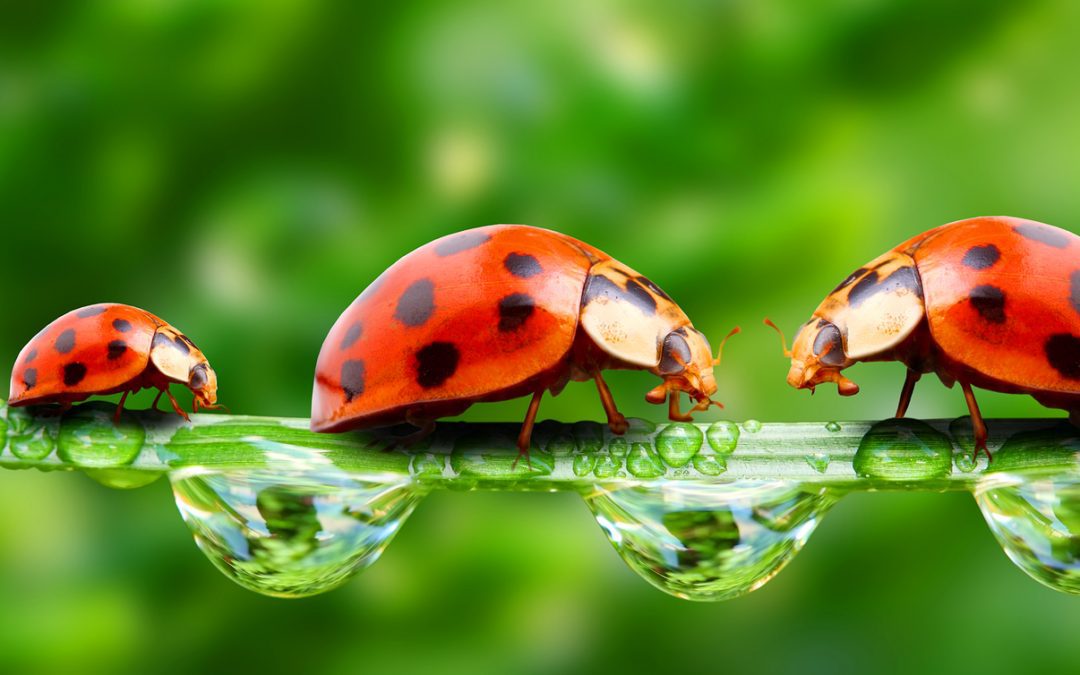- They’re not bugs, they’re lady beetles.
The name ladybug was coined by European farmers who prayed to the Virgin Mary when pests began eating their crops. Ladybugs wiped out the invading insects, and the farmers named them “Beetle of our Lady.” Later it was shortened to “lady beetle” and “ladybug”. In Europe, they’re called ladybird beetles.
- Ladybug Classification
Kingdom: Animalia (All animals)
Phylum: Arthropoda (Invertebrates)
Class: Insect (Insects)
Order: Coleoptera (Beetles)
Family: Coccinellidae Lady beetles
Genus: Hippodamia (Lady beetle type)
Species: Converges (specific Ladybug)
- Ladybugs are Feasters
Ladybugs may snack on a bit of plant matter here and there, but their favorite meal is other bugs. As soon as ladybugs hatch, they begin to feast. The newly hatched larvae eats about 350 to 400 aphids in a two-week period. Along with aphids, they eat fruit flies, mites, and other insects. This makes them a welcome guest of farmers and gardeners alike. A single ladybug can eat up to 5000 aphids in its short lifetime.
- Colorful Ladybugs Can Stink
The most common color is a red bug with black spots. There are about 5,000 species of ladybugs around the world including 500 in the U.S. A ladybug can be yellow, orange, brown, pink or even all black. Their color and spots are their markings to tell predators “eat something else.” When threatened, the bug will secrete an oily, foul-tasting fluid from joints in their legs. If you’ve ever heard that ladybugs can have stinky feet, this explains why. Much like opossums, they have been known to play dead – giving them a two-prong defense system against being eaten.
- Spots for Good Style and Bad Taste
One common myth about the ladybug’s famous spots says they indicate the beetle’s age. That’s false, but their spots do say something. They work in collaboration with their color to warn would-be attackers of the beetle’s terrible taste. Spot numbers and patterns vary from one species to the next, and some ladybug species don’t have any spots.
- Size and Length and Speed.
Ladybugs are round with a semi-circle shape, they have short legs and antennae, and tiny heads. The average length of a ladybug is .3 to .4 inches. Their spotted domed backs are made of modified wings that are basically hardened armor, but they are slender and perfect for a quick take off when the beetle needs to fly. Remarkably, scientists have clocked ladybird beetles flying at 37 miles per hour!
- Life Span
After a female lays her eggs, they hatch within three and ten days, depending on ambient temperature. The larva will grow for about a month before it enters the pupal stage which lasts 15 days. After the pupal stage, the adult ladybug can live from 2 to 3 months up to a year.
- Habitat
During the spring and summer, ladybugs are found in various habitats – common gardens, grasslands, wooded areas, suburbs, agricultural fields and even near flowing water. In the breeding season, ladybugs forage for food and deposit their eggs under leaves. In the winter months ladybugs disappear signaling it’s time to mate. After mating, they fall into a deep sleep which is much like a hibernation. Ladybugs gather in a large cluster to keep warm.
- Love for the Lady(bugs)
Ladybugs serve many beneficial roles in home gardens and the environment, because they prey on tiny insects that can destroy flowers and crops. Garden ladybugs get rid of unwanted pests and their eggs. Ladybugs are natural various predators; they eat aphids, scales, mealy bugs, leafhoppers, mites, and other insects. Many farmers rely heavily on ladybug populations to help maintain pest control for their crops. Ladybugs can even adapt to living in trees, feeding on harmful tree dwelling insects.
The ladybug is well-known and loved by children, gardeners and farmers alike. Next time you see ladybugs in an area of leaves, remember they’re a friend to healthy gardens and no threat to you or your family.


Recent Comments